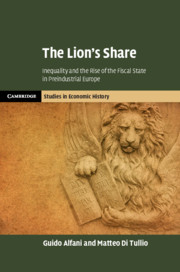Refine search
Actions for selected content:
26946 results in Economic history
Acknowledgements
-
- Book:
- The Lion's Share
- Published online:
- 04 February 2019
- Print publication:
- 07 February 2019, pp xi-xii
-
- Chapter
- Export citation
4 - Taxation, Redistribution and Inequality
-
- Book:
- The Lion's Share
- Published online:
- 04 February 2019
- Print publication:
- 07 February 2019, pp 133-180
-
- Chapter
- Export citation
1 - The Venetian Fiscal System
-
- Book:
- The Lion's Share
- Published online:
- 04 February 2019
- Print publication:
- 07 February 2019, pp 19-56
-
- Chapter
- Export citation
Archival Sources
-
- Book:
- The Lion's Share
- Published online:
- 04 February 2019
- Print publication:
- 07 February 2019, pp 200-200
-
- Chapter
- Export citation
Index
-
- Book:
- The Lion's Share
- Published online:
- 04 February 2019
- Print publication:
- 07 February 2019, pp 226-232
-
- Chapter
- Export citation
2 - The Rich and the Poor
-
- Book:
- The Lion's Share
- Published online:
- 04 February 2019
- Print publication:
- 07 February 2019, pp 57-90
-
- Chapter
- Export citation
Printed Sources
-
- Book:
- The Lion's Share
- Published online:
- 04 February 2019
- Print publication:
- 07 February 2019, pp 201-201
-
- Chapter
- Export citation
Tables
-
- Book:
- The Lion's Share
- Published online:
- 04 February 2019
- Print publication:
- 07 February 2019, pp ix-x
-
- Chapter
- Export citation

The Lion's Share
- Inequality and the Rise of the Fiscal State in Preindustrial Europe
-
- Published online:
- 04 February 2019
- Print publication:
- 07 February 2019
Information brokers and the making of the Baring crisis, 1857–1890
-
- Journal:
- Financial History Review / Volume 25 / Issue 3 / December 2018
- Published online by Cambridge University Press:
- 30 January 2019, pp. 357-386
-
- Article
- Export citation
Institutional equity investing in Britain from 1900 to 2000
-
- Journal:
- Financial History Review / Volume 26 / Issue 1 / April 2019
- Published online by Cambridge University Press:
- 30 January 2019, pp. 1-19
-
- Article
- Export citation
Political connections and stock returns: evidence from the Boulangist campaign, 1888–1889
-
- Journal:
- Financial History Review / Volume 25 / Issue 3 / December 2018
- Published online by Cambridge University Press:
- 25 January 2019, pp. 323-356
-
- Article
- Export citation
Chapter Fifteen - The Grain Question as the Social Question: Necker's Antiphysiocracy
-
-
- Book:
- The Economic Turn
- Published by:
- Anthem Press
- Published online:
- 12 February 2019
- Print publication:
- 16 January 2019, pp 505-584
-
- Chapter
- Export citation
Chapter Sixteen - Physiocracy in Sweden: A Note on the Problem of Inventing Tradition
-
-
- Book:
- The Economic Turn
- Published by:
- Anthem Press
- Published online:
- 12 February 2019
- Print publication:
- 16 January 2019, pp 585-606
-
- Chapter
- Export citation
Chapter Twenty - No Way Back to Quesnay: Say's Opposition to Physiocracy
-
-
- Book:
- The Economic Turn
- Published by:
- Anthem Press
- Published online:
- 12 February 2019
- Print publication:
- 16 January 2019, pp 677-698
-
- Chapter
- Export citation
Chapter Six - François Véron de Forbonnais and the Invention of Antiphysiocracy
-
-
- Book:
- The Economic Turn
- Published by:
- Anthem Press
- Published online:
- 12 February 2019
- Print publication:
- 16 January 2019, pp 139-168
-
- Chapter
- Export citation
Chapter Seven - Between Mercantilism and Physiocracy: Forbonnais's ‘Est modus in Rebus’ Vision
-
-
- Book:
- The Economic Turn
- Published by:
- Anthem Press
- Published online:
- 12 February 2019
- Print publication:
- 16 January 2019, pp 169-192
-
- Chapter
- Export citation
Chapter Two - The Physiocratic Movement: A Revision
-
-
- Book:
- The Economic Turn
- Published by:
- Anthem Press
- Published online:
- 12 February 2019
- Print publication:
- 16 January 2019, pp 35-70
-
- Chapter
- Export citation
Chapter Eight - Physiocrat Arithmetic versus Ratios: The Analytical Economics of Jean-Joseph-Louis Graslin
-
-
- Book:
- The Economic Turn
- Published by:
- Anthem Press
- Published online:
- 12 February 2019
- Print publication:
- 16 January 2019, pp 193-220
-
- Chapter
- Export citation
Chapter Three - The Political Economy of Colonization: From Composite Monarchy to Nation
-
-
- Book:
- The Economic Turn
- Published by:
- Anthem Press
- Published online:
- 12 February 2019
- Print publication:
- 16 January 2019, pp 71-88
-
- Chapter
- Export citation
